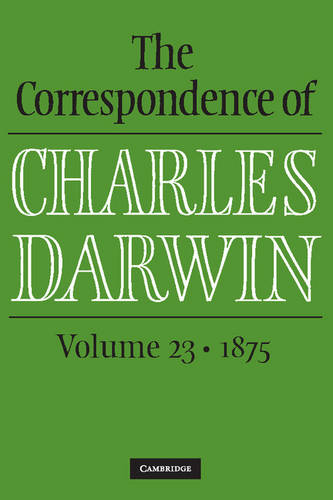
The twenty-third volume of Charles Darwin’s correspondence comprises all the surviving letters both from and to Darwin from the year 1875.
During the year, Darwin revised The Movements and Habits of Climbing Plants for its second edition, wrote and published Insectivorous Plants, and began detailed research for The Effects of Cross and Self Fertilisation in the Vegetable Kingdom.
The year 1875 also saw the death of Darwin’s great friend and inspiration the geologist Sir Charles Lyell, and of two other Darwin allies: American philosopher and mathematician Chauncey Wright; and historian, explorer and philosopher William Winwood Reade.
During 1875, Darwin uncharacteristically became actively involved in a matter of public controversy in the form of a national debate on vivisection. In this volume, we encounter:
- Darwin’s sharing his thoughts on vivisection with his daughter Henrietta Litchfield.
- Darwin subsequently alerting his friend Thomas Henry Huxley to the fact that vivisection debate is likely to become a pressing issue. Although generally sympathetic to the cause, Darwin’s primary concern seems to be damage-limitation.
- Darwin reporting working with a solicitor on a petition concerning the forthcoming vivisection bill, clearly concerned about “the zealots of the Cruelty Soc.”. He also writes a long letter to Lord Derby, which is subsequently forwarded to the Home secretary.
- Darwin writing to the Royal Commission on vivisection after having given evidence, expressing concerned that a proposed alternative bill would outlaw any vivisection taking place without anaesthetic.
Other highlights from Darwin’s correspondence for 1875 include:
- Philologist Friedrich Max Müller politely disagreeing with Darwin on the animal origin of human language.
- Darwin (not for the first time) cutting off all contact with his former friend St George Jackson Mivart after a second bitter dispute between the two men the previous year.
- Darwin, while working on the manuscript of Insectivorous plants and the second edition of Climbing plants reporting, “I am slaving away solely at making detestably bad English a very little less bad.” And, a short whole later, declaring, “You ask about my book & all that I can say is that I am ready to commit suicide”.
- Darwin receiving an insulting poem, on the back of which he notes, ‘An anonymous compliment’.
- Darwin paying tribute to the recently deceased Sir Charles Lyell. And again. Plus Joseph Dalton Hooker’s tribute, explaining that he has arranged to Lyell to be buried in Westminster Abbey.
- A long letter from Chauncey Wright on the function of eyelashes, eyebrows, etc., and Darwin’s amusing anecdote about a sweaty crewman from HMS Beagle who ‘skedaddled’ when locals tried to alleviate the pain in his eyelids with a woman’s breast-milk.
- A letter from a former royal marine aboard HMS Beagle, who recalls alerting Darwin to a volcanic eruption, and asks for Darwin’s portrait (which Darwin sends).
- Darwin commenting on a portrait he has just sat for: “I look a very venerable, acute melancholy old dog,— whether I really look so I do not know.”
- Darwin’s son George’s sceptical account of séance.
- Darwin’s near neighbour, John Lubbock, reporting having tried to get to the bottom of the local vicar’s personal animosity to Darwin, and Darwin replying he thinks the vicar is being ridiculous.
- Lubbock’s wife sending Darwin a poem about his new book, Insectivorous Plants.
- Darwin commenting on his first book, Journal of Researches (now generally known as The Voyage of the Beagle): “I always feel towards this book, like a mother to her first-born child”.
- Darwin commenting on his latest book, Insectivorous Plants: “no one except a lunatic will read it”. He later observes, “I never can help making my books too long”.
- Darwin providing a brief account to Adam Sedgwick’s biographer of his 1831 field trip around North Wales with Sedgwick, recalling how neither he nor Sedgwick noticed the obvious signs of past glaciation.
- A letter from a female correspondent questioning Darwin’s and Francis Galton’s views on women’s intelligence. She plans to carry out research.
- Darwin being sent an anecdote demonstrating the intelligence of dogs.
- Darwin making observations for John Tyndall, testing for the spontaneous generation of life.
- Darwin observing, “Heaven only knows: I ought perhaps to avoid general and large subjects as too difficult for me with my advancing years, and I suppose enfeebled brain”.
- Darwin trying (ultimately successfully) to get Edwin Ray Lankester admitted into the Linnean Society after his unfair blackballing for in-house political reasons.
- Darwin suggesting George John Romanes try grafting live pigeon skins.
- Bartholomew James Sulivan sending the latest news of former HMS Beagle crew members.
As with all the volumes in this series, this book is really aimed at people with a serious interest in Charles Darwin. As with all the other volumes, every letter is annotated with meticulously researched footnotes explaining its context and references. The series as a whole is a masterpiece of scholarship.
- Buy this book from Bookshop.org (UK) and help tax-paying, independent bookshops.
- Buy this book from Amazon.co.uk
- Buy this book from Amazon.com